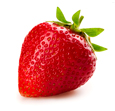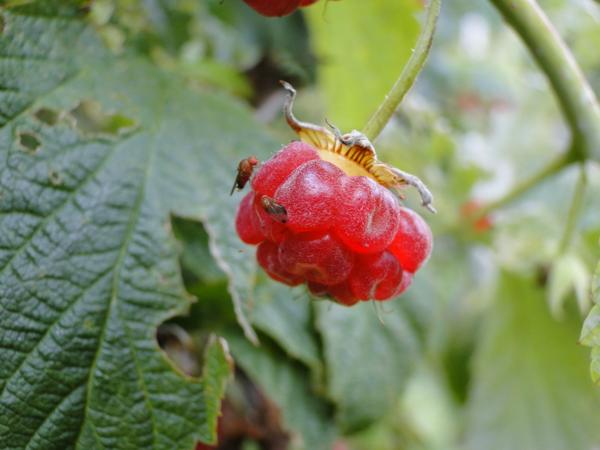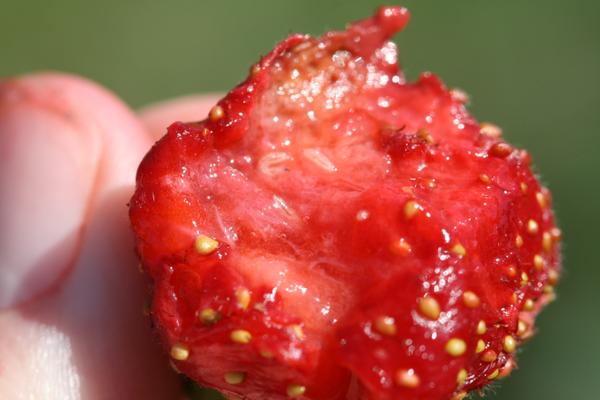Spotted Wing Drosophila
- Scientific Name(s)
- Drosophila suzukii
- Type
- Arthropod (or insect)
- Fruit Condition
- Insect inside fruit, fruit sound
- Field Distribution
- Uniform
- Season
- Harvest
- Cropping System
- Annual plasticulture, Perennial matted row
Biology
Spotted wing drosophila (SWD, Drosophila suzukii) is an invasive pest of soft skinned fruit which has been detected throughout the United States in the years since 2008. Adult SWD are small (2-3 mm) light brown flies. Male SWD have a distinctive spot on the end of both wings and dark bristles in bands around the base of the last segment on their front legs (called sex combs). Female SWD lack spots on their wings but can be distinguished by a relatively large, blade-like ovipositor (egg laying devise) at the end of their abdomen. Not all flies with spots on their wings are spotted wing drosophila. This Penn State factsheet illustrates other flies that may present in SWD traps.
It is difficult to visually distinguish SWD larvae from native, non pest Drosophila species. Drosophila larvae are up to 3 mm long, do not have legs or a clearly defined head, and are tapered on both ends. They have two dark “mouth hooks” at the front.
Damage in Strawberries
Female SWD preferentially lay their eggs in ripe and ripening fruit, unlike nearly all other Drosophila species but do not appear to attack completely green, unripe fruit. The resulting larvae feed inside fruit, causing direct damage, and may also be present at harvest, contaminating the product.
SWD infestations in North Carolina have been most significant in caneberries (blackberries & raspberries) but can also be common in blueberries and strawberries. While SWD have been found in spring fruiting strawberries, particularly in unmanaged research plots, they may be a more significant risk later in the growing season and in summer fruiting, day neutral strawberries.
Scouting and Thresholds
Adult SWD can be monitored with traps baited with either apple cider vinegar or a yeast and sugar slurry. Yeast and sugar baits were more attractive than vinegar in 2012 and 2013 experiments. See Spotted Wing Drosophila Monitoring Recommendations for 2013 for a step by step trapping guide. Some commercial lures for SWD are also becoming available. However, all attractants may be less attractive compared to ripe fruit , so they should only be used to determine SWD presence or absence in an area at this time.
In addition to adult trapping, fruit should be carefully monitored for SWD larvae. You can learn more about fruit sampling from this factsheet. Carefully select only marketable-appear fruit to sample. If fruit is overripe or otherwise damaged, other insects may also be present. See Identifying Insects That May Be Present in Strawberry Fruit for information on distinguishing Drosophila larvae from other insects that may be present in strawberries.
Management Options
SWD infestation can reach 100% if left unchecked. If adult SWD are present in your area, aggressive management is warranted. Aggressive management entails:
- Excellent sanitation: Fruit should be harvested frequently and completely. Any unmarketable fruit should be removed from the field and either frozen, “baked” in clear plastic bags placed in the sun, or hauled off site to kill or remove any larvae present.
- Water management: Leaking drip lines should be repaired, and overhead irrigation should be minimized.
- Insecticide treatments: Treatments should be applied at least every seven days and repeated in the event of rain. Effective insecticides with pre harvest intervals amenable to picking schedules should be selected, and insecticide modes of action should be rotated between each treatment. There are some organic tools available for SWD, but they may be less persistent than conventional materials. Organic growers should also be careful to avoid exceeding maximum applications per season. See below for links to specific recommendations.
- Regular fruit sampling: Fruit should be observed for larvae at every harvest.
Conventional insecticides
Several conventional insecticides are effective against SWD, but because these treatments are made during harvest, care must be taken to select materials with appropriate preharvest intervals. Refer to the North Carolina Agricultural Chemicals Manual for materials recommended for use against SWD in North Carolina and the Southern Region Small Fruit Consortium Strawberry IPM Guide for regional recommendations.
Organic insecticides
Effective organic insecticide options are limited. Refer to the North Carolina Agricultural Chemicals Manual for materials recommended for use against SWD in North Carolina and the Southern Region Small Fruit Consortium Strawberry IPM Guide for regional recommendations.







